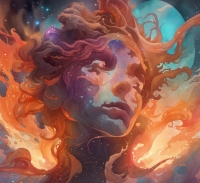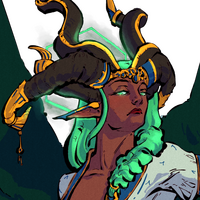Festival of Creation
Shuyettan stagyars welcome the month of Nobeskhet with a festival celebrating their creation. In the morning, stagyars don expressionless masks depending on their elements. They act withdrawn and absentminded, dancing in the streets and taking no mind to surrounding people. As the mid-day approaches, stagyars speak their names, take the masks off, and break them with magic. The act symbolises the elements finding their individual names and gaining a sense of self, breaking free from the mindless existence.
The day carries on with festivities. Vendors open up food booths, selling honey cakes, dried fruits, sweetened milk, different flavoured ice cream and date loaves shaped into various animals. Actors call for the audience, enticing them to watch the performance. The most popular play depicts freedom-fighter Phendarakhuan. Children cheer as he defeats the wretched slave owners and imprisons the criminals with their own chains.
Flying island merchants are quick to open up bazaar stalls, offering the best selection of embroidery-adorned fabric, tapestry, rugs, exotic food and spices from all over Ayonerra. Shuyettans, in turn, sell them stained glass cups, jewelry and other colourful accessories.
One of the most beloved Shuyettan dances is performed by the five common elements: air, earth, fire, water, and lightning. They place sand in the middle of the field, representing Rakheem, the first stagyar and the Desert of Creation.
The dancers shift into the elemental forms. Initially, their movements are weightless and erratic. As the performance continues, each dancer slowly manifests their corporeal body. Loose and faint at first, but gradually becoming firmer. Air is the first to gain flesh, representing Nurarin, the second stagyar and Rakheem's beloved wife. Other elements are quick to follow.
One of Rakheem's six forms, the Fox, often emerges from the surrounding sands and watches the performance. Sometimes, the air gently brushes against the dancers, as if caressing them in a motherly embrace.
The day carries on with festivities. Vendors open up food booths, selling honey cakes, dried fruits, sweetened milk, different flavoured ice cream and date loaves shaped into various animals. Actors call for the audience, enticing them to watch the performance. The most popular play depicts freedom-fighter Phendarakhuan. Children cheer as he defeats the wretched slave owners and imprisons the criminals with their own chains.
Flying island merchants are quick to open up bazaar stalls, offering the best selection of embroidery-adorned fabric, tapestry, rugs, exotic food and spices from all over Ayonerra. Shuyettans, in turn, sell them stained glass cups, jewelry and other colourful accessories.
Gratitude towards the Desert of Creation
The dancers shift into the elemental forms. Initially, their movements are weightless and erratic. As the performance continues, each dancer slowly manifests their corporeal body. Loose and faint at first, but gradually becoming firmer. Air is the first to gain flesh, representing Nurarin, the second stagyar and Rakheem's beloved wife. Other elements are quick to follow.
One of Rakheem's six forms, the Fox, often emerges from the surrounding sands and watches the performance. Sometimes, the air gently brushes against the dancers, as if caressing them in a motherly embrace.









Oh, I like how the masks are static and expressionless at the beginning and then change and disappear as the day goes on. I would also love to see the elements represented with dance. I love it.
Thank you!